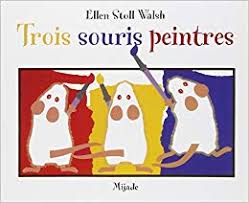This article was written for the inter-bloggers event « Le support visuel dans l’apprentissage d’une langue étrangère/Visual support in the learning of a foreign language », organised by the blog Le français illustré.
As you may or may not know, I am often referred to as “the French bus lady”, because I drive around the north east of England on my 7.5t mobile library bus; on it, I share stories, mostly in French, with children typically from the ages of 2 to 13. I also have a few stories in Spanish and German, and I work with younger and older children too.
What made me do this? It is not just because I love telling stories: of course I do, but it is because I know there is a point to it: the sharing of picture books aids language learning.
I cannot actually remember when I started using picture books in my teaching, but I remember taking part in a French Day at a local primary school back in 2014 and using the story “Trois souris peintres” with children from the age of 4 to the age of 11; I did not use it in the same way at all levels but managed to adapt what I did with the book so that all the children were able to enjoy the story in French. The head teacher was very complimentary about my activities and their impact, which got me thinking, and this is how it all started. I am now an expert in French picture books: I have just spent 4 days in Paris at the “Salon du Livre et de la Presse Jeunesse” discovering new stories, meeting authors, attending seminars… This is how dedicated I am to this part of my “work”!

What makes picture books so unique in language teaching and learning? The pictures of course! I use stories where there is a close relationship between the text and the illustrations, where they complement each other. The pictures help the children to make sense of the stories, but they also add to it. As the children are visually involved, they are more engaged with the narratives, which makes them more involved emotionally too. Illustrations also appeal to our sense of aesthetics. On top of this, certain colours have the power to conjure up certain feelings.
How do the children benefit from being read picture books in another language? Children (and adults) naturally love stories; being able to share stories is something that makes human beings unique. General listening skills are being developed as a book is being read; when the children can take part in the story, their speaking skills are improving too. If children are being read stories in another language from a young age (ie before they reach secondary school), they become used to the different sounds and used to listening to a language that they may not understand; they accept it and are not fazed by longer texts later on. Picture books can be used to introduce new vocabulary or to reinforce known phrases in context. The learning seems more relevant and real; moreover, when the children can understand a story which was written for children who are fluent in the language of the text, it makes them feel proud that they can follow it too.
How do I actually use picture books? There is no right or wrong way of doing it, so I would say just give it a go if you have not done so already! I always start by showing the cover and discussing, in English, what the story might be about. Then, more often than not, I read it all in French. Some picture books lend themselves to the children taking part in the storytelling, especially if a certain phrase or sentence is repeated for instance; I might therefore teach them it before we start sharing it together. Other stories are so short and simple that the children can just repeat each sentence after me, then memorise them and eventually tell the story themselves. If the story is quite lengthy or the language difficult, I will sometimes pause during the first reading to allow the children to try to predict what is going to happen next. I may also ask questions in Englsih to check their understanding; a lot of the work done with picture books comes down to appropriate questioning and what you ask the children to do with the story: you would not for instance expect a primary school child to translate a whole text from French to English.
In the classroom where I have access to a visualiser, I can actually show the text to the children and we can then work more closely on our reading skills. Most picture books also lend themselves to follow-up writing tasks, like making mini-books, changing the characters in the text, altering the ending etc.
Picture books can also be used to highlight certain cultural differences between countries, including their festivals.
This was a non-exhaustive list of all the advantages of using illustrated stories!
If you would like any advice on which French picture books to choose or how you can exploit a certain story, please check out my blog here. If you have any questions, do ask them in the comments below so everyone can benefit from the answers.
Thanks for reading!

